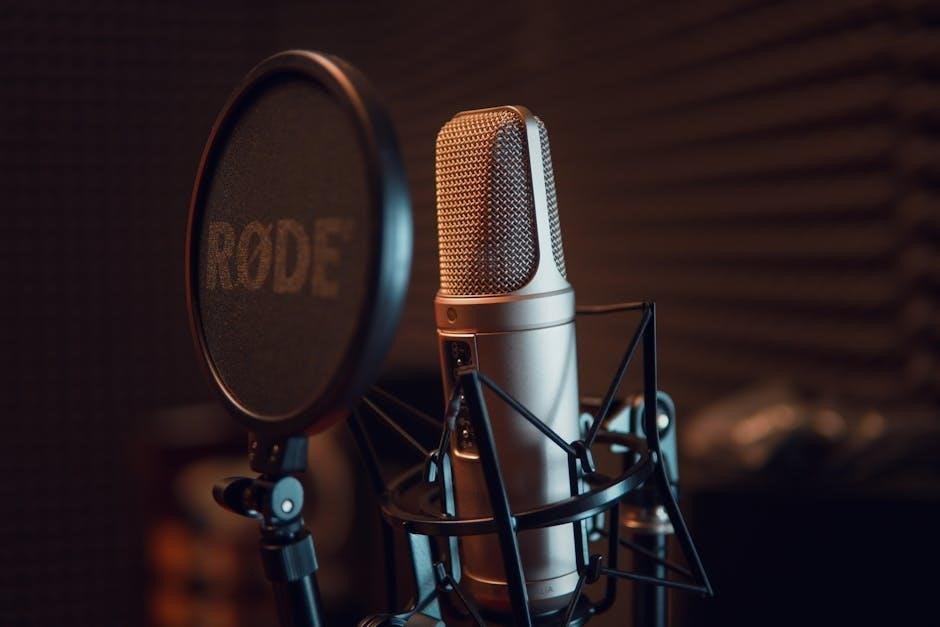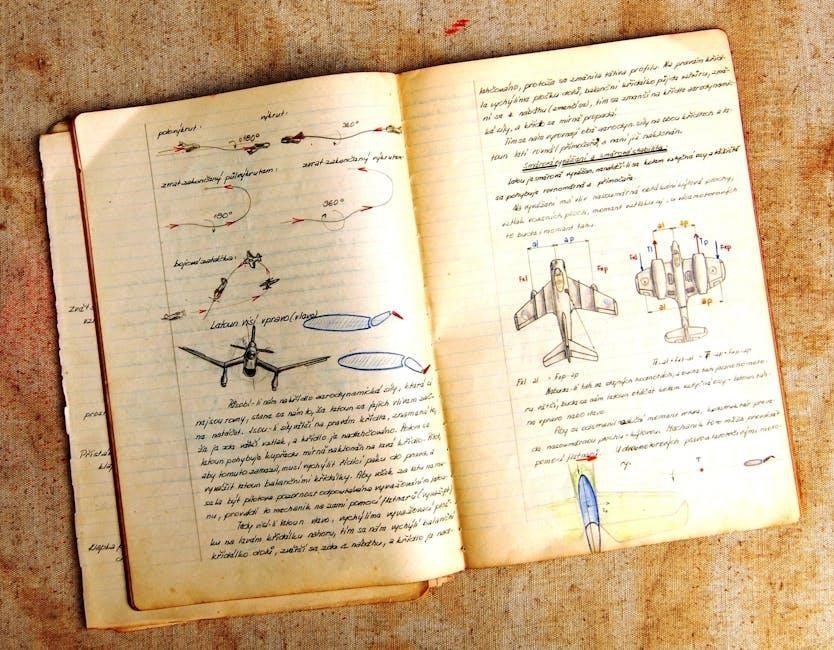Welcome to the Philips Voice Tracer manual, your comprehensive guide to unlocking the full potential of your digital voice recorder. This manual provides detailed instructions for setting up, recording, and maintaining your device, ensuring optimal performance and ease of use. Discover key features, troubleshooting tips, and advanced settings to enhance your audio recording experience.
Purpose and Importance of the Manual
This manual serves as your essential guide for understanding and utilizing the Philips Voice Tracer effectively. It provides clear instructions for setup, operation, and troubleshooting, ensuring you get the most out of your device. Whether you’re recording lectures, meetings, or personal notes, this manual offers step-by-step guidance to help you navigate features, resolve common issues, and maintain your voice recorder. By following the instructions, you can optimize performance, extend device longevity, and enhance your overall recording experience.
Overview of the Philips Voice Tracer Series
The Philips Voice Tracer series offers a range of digital voice recorders designed for professional and personal use. Models like the DVT1100, DVT1150, and DVT2050 feature compact designs, high-quality microphones, and robust storage capabilities. These devices are engineered to capture clear audio in various environments, with options for MP3 recording and USB connectivity. The series caters to diverse needs, from everyday note-taking to advanced audio capture, making it a versatile tool for both enthusiasts and professionals seeking reliable recording solutions.

Key Features and Specifications
The Philips Voice Tracer series boasts high-quality recording capabilities, adjustable microphone sensitivity, and multiple storage options. It supports various audio formats and offers seamless connectivity for file transfers;
Internal Memory and Storage Capacity
The Philips Voice Tracer series offers varying internal memory capacities, such as 8 GB, enabling extended recording sessions. Certain models support microSD card expansion, allowing additional storage for thousands of hours of audio. For instance, the DVT2050 and DVT1110 models provide ample space for high-quality recordings. The internal memory ensures seamless storage of files, while expandable options cater to users requiring larger capacities. This feature-rich design ensures the device meets diverse recording needs, from short notes to prolonged sessions, making it a versatile tool for professional and personal use.
Recording Formats and Quality Settings
The Philips Voice Tracer supports multiple recording formats, including MP3 and PCM, catering to various audio quality needs. Users can select from different quality settings, such as high, medium, or low, to balance file size and sound clarity. The device also features voice activation, which automatically starts recording when sound is detected, optimizing storage usage. Additionally, noise reduction settings help minimize background interference, ensuring crisp and clear recordings. These customizable options allow users to tailor their recording preferences for professional or personal use, enhancing overall audio capture efficiency and quality.
Microphone Sensitivity and Noise Reduction
The Philips Voice Tracer features adjustable microphone sensitivity, allowing users to optimize audio capture in diverse environments. High sensitivity settings are ideal for distant or soft sounds, while lower settings reduce background noise. The device also includes advanced noise reduction technology, which minimizes unwanted ambient sounds, ensuring clearer recordings. These features are particularly useful in noisy settings, such as lectures or meetings, helping to deliver high-quality audio with minimal interference. Adjusting these settings can be done through the device’s menu, offering flexibility for various recording scenarios and enhancing overall sound quality.
Connectivity Options (USB, App Integration)
The Philips Voice Tracer offers seamless connectivity options for efficient file management and integration with other devices. Equipped with USB 2.0 high-speed connectivity, the device allows quick and easy transfer of recordings to computers. Additionally, the Philips Voice Tracer App enables wireless synchronization with smartphones, enhancing convenience for users on the go. This app integration supports real-time recording, file sharing, and organization, making it easier to manage your audio files across multiple platforms. These connectivity features ensure a smooth and user-friendly experience, catering to both professional and personal needs.

Setting Up the Philips Voice Tracer
Unbox and prepare your Philips Voice Tracer for first use, ensuring proper battery installation and initial setup. Connect to devices and install necessary software for optimal functionality.
Unboxing and Initial Setup
Carefully unbox your Philips Voice Tracer and ensure all accessories are included, such as the device, batteries, and USB cable. Insert the batteries as indicated in the manual, ensuring correct polarity to avoid damage. Power on the device and navigate through the initial setup menu to configure language, date, and time settings. Familiarize yourself with the buttons and controls for seamless operation. If required, connect the device to a computer via USB to charge or transfer files; Properly follow these steps to ensure optimal functionality from the start.
Installing Batteries and Power Management
To ensure proper function, stop the Philips Voice Tracer before replacing batteries to prevent file corruption. Use two AAA alkaline batteries, inserting them with correct polarity as shown in the compartment. For power management, enable the auto-off feature to conserve battery life when the device is inactive. Avoid exposing batteries to moisture or extreme temperatures. Replace batteries promptly when low-battery warnings appear to maintain uninterrupted recording performance. Proper battery care extends the device’s longevity and ensures reliable operation during important recordings.
Connecting to a Computer or Smartphone
To connect your Philips Voice Tracer to a computer, use the USB cable provided. Plug the device into a USB port, and it will automatically appear as a removable drive. For smartphone integration, download the Philips Voice Tracer App from the Google Play Store or Apple App Store. Once installed, follow in-app instructions to pair your device. This connection allows seamless file transfers, app control, and access to advanced features. Ensure proper connectivity for efficient data management and enhanced functionality.
Downloading and Installing the Philips Voice Tracer App
Download the Philips Voice Tracer App from the Google Play Store or Apple App Store. Once installed, launch the app and follow the on-screen instructions to connect your device. Ensure your smartphone and Voice Tracer are paired via USB or Wi-Fi for seamless integration. The app allows you to manage recordings, adjust settings, and transfer files effortlessly. Regularly update the app to access new features and improvements, ensuring optimal performance and compatibility with your Philips Voice Tracer.

Recording with the Philips Voice Tracer
The Philips Voice Tracer is designed for high-quality audio recording on the go. It features voice activation, auto-recording, and adjustable settings for optimal results in any environment.
Starting and Stopping a Recording
Starting and stopping a recording on the Philips Voice Tracer is straightforward. Press the dedicated record button to begin recording; the LED indicator will light up to confirm recording is active. To stop, press the same button again. The device automatically saves the file, organizing it by date and time for easy access later. Ensure the batteries are replaced before starting a recording to avoid file corruption. This intuitive process makes capturing audio seamless and efficient, whether in meetings, interviews, or personal notes.
Adjusting Recording Settings (Quality, Microphone Sensitivity)
Customize your recording experience by adjusting quality settings and microphone sensitivity. Choose from multiple quality modes, such as LP, SP, or HP, to balance file size and audio clarity. Access the menu to fine-tune microphone sensitivity, optimizing recordings for loud environments or faint voices. Higher sensitivity captures distant sounds, while lower settings focus on nearby audio, reducing background noise. These adjustments ensure your recordings are tailored to specific situations, enhancing overall sound quality and usability. Experiment with settings to find the perfect configuration for your needs.
Using the Device in Different Environments
Adapt your Philips Voice Tracer to various settings for optimal performance. In noisy environments, enable noise reduction to minimize background interference. For outdoor use, utilize the windscreen to reduce wind noise. Position the microphone closer to the speaker in quiet settings for clear audio capture. Adjust sensitivity settings to suit the space, ensuring high-quality recordings in both loud and soft environments. Experiment with these features to achieve the best results in any location, whether indoors, outdoors, or in challenging acoustic conditions.

Playback and File Management
Easily play back recordings, organize files by date or category, and delete unwanted files. Transfer recordings to your computer via USB for secure storage and sharing.
Playing Back Recordings
Playing back recordings on your Philips Voice Tracer is straightforward. Use the playback controls to start, pause, or skip recordings. The device organizes files by date and time, making it easy to locate specific recordings. Adjust the volume using the built-in speaker or connect external headphones for clearer audio. You can also fast-forward or rewind recordings for efficient review. The LCD screen displays file information, such as duration and format, ensuring a seamless playback experience. This feature-rich system allows you to manage and review your recordings with precision and convenience.
Organizing and Deleting Files
Your Philips Voice Tracer allows easy organization and management of recorded files. Files are stored in folders, often sorted by date, making it simple to locate specific recordings. To delete files, navigate to the file menu, select the desired recording, and confirm deletion. Regularly organizing and deleting files helps maintain storage capacity and ensures efficient access to important recordings. Use the device’s built-in file management system or connect to a computer for advanced organization. This feature ensures your Philips Voice Tracer remains clutter-free and functional, optimizing your recording experience.
Transferring Files to a Computer
Transferring files from your Philips Voice Tracer to a computer is a seamless process. Connect the device to your computer using a USB cable, and it will appear as a removable storage drive. Navigate to the folder containing your recordings, select the desired files, and drag them to your computer. Alternatively, use the Philips Voice Tracer App to wirelessly transfer files, ensuring easy backup and management. This feature allows you to free up storage space on your device while keeping your recordings securely stored on your computer.

Troubleshooting Common Issues
Troubleshoot battery life by checking power settings. Resolve connectivity issues by restarting the device or updating software. Recover deleted files using the Philips Voice Tracer App.
Resolving Battery Life Problems
To resolve battery life issues, turn off unnecessary features like Bluetooth or Wi-Fi when not in use. Enable power-saving mode to reduce consumption. Ensure batteries are installed correctly and avoid mixing old and new ones. Keep the device away from extreme temperatures, as this can drain the battery faster. Regularly check battery levels and recharge when needed. Avoid letting the battery completely drain to prolong its lifespan. For rechargeable batteries, use the original charger to maintain health. Refer to the manual or app for additional power management tips.
Fixing Connectivity Issues
If your Philips Voice Tracer is experiencing connectivity problems, start by ensuring the USB cable is securely connected to both the device and your computer. Restart the device and check for driver updates. For Bluetooth issues, reset the connection by turning Bluetooth off and on again. Ensure your device and computer or smartphone are paired correctly; If using the app, verify that it is installed correctly and that both devices are connected to the same network. Restarting the device or reinstalling the app often resolves connectivity issues. Always use the original USB cable provided with your Voice Tracer for optimal performance.
Recovering Deleted or Corrupted Files
To recover deleted or corrupted files on your Philips Voice Tracer, connect the device to your computer using the USB cable. Open the Philips Voice Tracer app or file explorer to locate the internal storage folder. Check the “Recycle Bin” or “Trash” for recently deleted files. If files are corrupted, ensure the firmware is up to date. Use file recovery software compatible with your device to restore lost data. Avoid recording new files until recovery is complete to prevent overwriting. Regular backups are recommended to prevent data loss in the future.

Advanced Features of the Philips Voice Tracer
Explore advanced features like voice activation, auto-recording, and customizable settings to enhance your recording experience. These tools help optimize performance and streamline your workflow efficiently.
Using Voice Activation and Auto-Recording
The Philips Voice Tracer offers voice activation, which starts recording when sound is detected, and auto-recording, which begins automatically at a set time. These features are ideal for hands-free operation and ensuring you never miss important audio. Voice activation sensitivity can be adjusted to minimize background noise, while auto-recording allows scheduling of recordings in advance. Enable these settings through the device menu to streamline your workflow and capture high-quality audio effortlessly, making it perfect for interviews, meetings, and lectures. This functionality enhances convenience and efficiency, ensuring seamless recording experiences.
Customizing Settings for Optimal Performance
Customize your Philips Voice Tracer to suit your needs by adjusting settings like microphone sensitivity, recording quality, and noise reduction. Access the menu to fine-tune these options, ensuring crystal-clear audio in any environment. Adjust microphone sensitivity to capture distant or soft voices, while noise reduction minimizes background interference. Select from various recording formats and quality levels to balance file size and sound fidelity. These adjustments enable tailored performance, enhancing recording accuracy and user experience. Experiment with settings to find the perfect configuration for your specific use case, whether it’s lectures, interviews, or personal notes.

Maintenance and Care
Regularly clean the device with a soft cloth and avoid exposing it to moisture. Protect the microphone from dust and ensure proper battery storage for longevity.

Cleaning the Device
Regular cleaning ensures optimal performance of your Philips Voice Tracer. Use a soft, dry cloth to wipe the exterior and avoid harsh chemicals or liquids. For the microphone, gently brush away dust with a soft-bristled brush. Never insert liquids or cleaning solutions, as this may damage internal components; Keep the device away from extreme temperatures and moisture to prevent malfunction. Proper cleaning maintains sound quality and extends the lifespan of your Voice Tracer. Always refer to the manual for specific care instructions tailored to your model.
Updating Firmware and Software
Regular firmware and software updates are essential to ensure your Philips Voice Tracer functions optimally. To update, connect the device to your computer via USB and use the Philips Voice Tracer app or visit the official Philips website. Follow on-screen instructions to download and install the latest version. Automatic updates may also be available via Wi-Fi, depending on your model. Always back up recordings before updating and avoid interrupting the process to prevent data loss or device malfunction. Keeping your software up-to-date enhances performance, adds new features, and fixes potential bugs.

Legal and Safety Information
Ensure compliance with regulations and safety standards when using the Philips Voice Tracer. All trademarks are owned by Koninklijke Philips N.V. Manufacturer disclaims liability for non-compliance damages.
Compliance with Regulations
The Philips Voice Tracer is designed to comply with international regulatory standards, ensuring safe and reliable operation. Always follow local laws and safety guidelines when using the device. Protect the recorder from moisture and liquids to prevent damage or electrical hazards. Manufacturer disclaims liability for damages resulting from non-compliance with safety instructions. Ensure proper handling and adherence to environmental regulations for battery disposal. This device is intended for legal use only, and any unauthorized modifications may void its warranty. By using the Philips Voice Tracer, you agree to abide by all applicable regulations and safety precautions.
Safe Usage Guidelines
Always follow safety guidelines to ensure optimal performance and longevity of your Philips Voice Tracer. Avoid exposing the device to moisture or liquids, as this may cause damage or electrical issues. Use only original Philips batteries and accessories to maintain safety and functionality. Keep the recorder away from extreme temperatures and harsh environments. Regularly clean the device and store it in a dry place when not in use. Ensure proper handling of batteries to prevent leakage or corrosion; By adhering to these guidelines, you can enjoy safe and reliable recording experiences with your Philips Voice Tracer.
Mastering your Philips Voice Tracer enhances your recording experience. Explore advanced features, maintain proper care, and refer to the manual for troubleshooting. Happy recording!
Final Tips for Maximizing Device Potential
To maximize your Philips Voice Tracer’s performance, regularly update its firmware for the latest features and improvements. Experiment with recording settings to optimize audio quality in different environments. Organize files into folders for easy access and avoid clutter. Consider exporting important recordings to a computer or cloud storage for safekeeping. Clean the microphone and device exterior periodically to maintain sound clarity. For the best experience, use original Philips accessories and refer to the manual for troubleshooting common issues. Happy recording!
Where to Find Additional Resources and Support
For further assistance, visit the official Philips website to access user manuals, software updates, and FAQs. Explore the Philips Voice Tracer PDF manuals available for models like DVT2050 and DVT2110. Join online forums and communities dedicated to voice recorders for peer support. Contact Philips customer support directly for personalized help. Additionally, refer to the resources section on the Philips website for troubleshooting guides and instructional videos. These resources ensure you can fully utilize your device’s capabilities and resolve any issues promptly.

